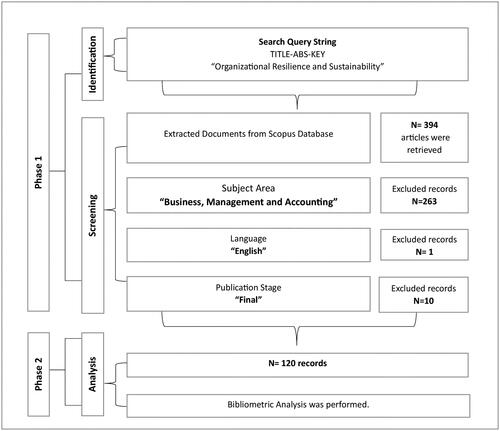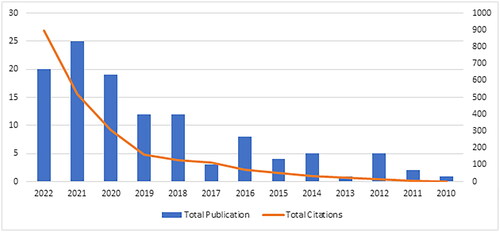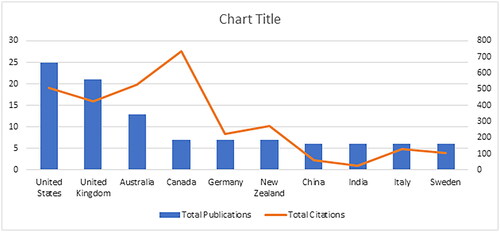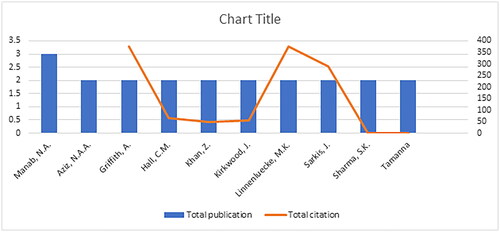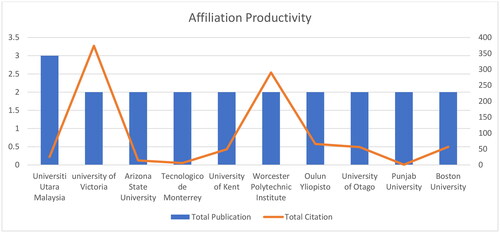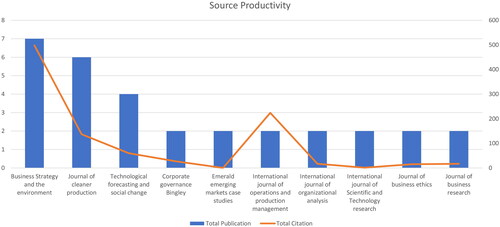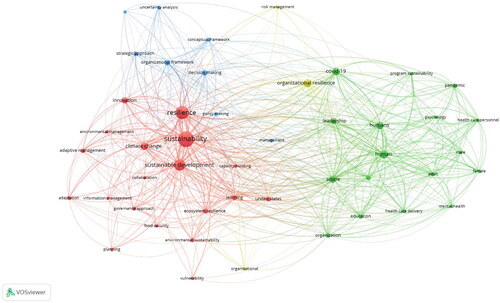Abstract
Amidst uncertain and disruptive environments, the significance of Organizational Resilience and Sustainability cannot be overstated, as they are crucial for businesses to thrive. By integrating sustainability and resilience practices into strategies, organizations can better navigate disruptive environments and position themselves for sustainable success. The aim of conducting a bibliometric study on organizational sustainability and resilience is to gather knowledge of the literature already written in these fields and spot trends, patterns, and research gaps. The present study sheds light on the four Organizational Resilience pillars: Preparedness, Responsiveness, Adaptability, and Learning. These pillars are crucial in enhancing an organization’s ability to withstand and recover from disruptive events. Using the Scopus Database, a comprehensive analysis was conducted on 120 documents that satisfied the inclusion criteria and were published between 2010 and 2022. Descriptive Statistical Analysis was employed to examine and comprehend the extent to which previous research has explored organizational resilience and sustainability within Business Management. The analysis focused on factors such as production productivity, country productivity, affiliation productivity, author productivity, and the most cited document.
REVIEWING EDITOR:
Introduction
The past few years have been subject to unsettling, disruptive situations for many organizations. Such disruptions are not new concepts; organizations have gained stability against them. However, these problematic situations have multiplied and become more challenging for managers and leaders. Organizations often face obstacles due to constantly changing scenarios, such as evolving technologies, changing customer expectations, and shifts in the social, cultural, political, and legislative environment. The current risk management frameworks need upgradation and must be compatible with these uncertain situations. Making our organizations resilient is an essential condition. Resilience is the ability to bounce back from unstable situations and adapt to such problems. Organizations must seek to be more resilient towards unsettling situations. Resilience is adapting to challenging or disruptive conditions through mental, emotional, and behavioral flexibility.
Organizational resilience is the competence of an organization to forecast, devise, act, and adapt to change and the unsteady situation to survive (Denyer, Citation2017). The Organizational Resilience (OR) concept is gaining attention from top management journals. Still, this topic is considered vague, and it needs practical implications. A clear definition and measurable concept are required for scientific relevance. Organizational resilience is the capability-based conceptualization of an organization to evolve itself and move forward after disruptive situations (Duchek, Citation2020). Organizational resilience will help leaders make fast decisions due to business challenges. Companies seeking to become resilient organizations should resign the whole process, not just a few relevant processes for probable disruptive events of organizations (Shepherd & Williams, Citation2022). The manager needs to make preventive decisions against uncertainties, so the companies should work on strategic adaptation instead of strategic planning (Fiksel, Citation2003). Resilience is not only adopted by the private or public sector; whole economies and societies can also be resilient. Being resilient means the organizations are forward-looking, forecasting disruptions by continuous monitoring and evolving based on experiences.
Organizational resilience is formed on four pillars: preparedness, responsiveness, adaptability, and learning (Koronis & Ponis, Citation2018). Preparedness refers to the understanding of possible threats and risks as well as awareness of solutions towards such threats and challenges; Responsiveness refers to the time required for successful implementation of a plan towards a challenge; Adaptability refers to adjusting to new ecology and processing the change after crisis; Learning refers to absorb the knowledge gained after the crisis by evaluating the risks, acknowledging problems and possible solutions. Along these pillars, an organization must have a cultural and social capital foundation, such as trust and a magnificent identity. Only an organization can act freely during a crisis.
The concept of ‘Resilience’ is taken from ecology, where sustainability is treated as a characteristic of the evolving system rather than an absolute goal. Due to continuous disruptions and discontinuities that shift present equilibrium, organizational resilience, and sustainability are essential concepts to learn. The discontinuities include changing technologies, developing new market forces, and changing availability of resources. Sustainability refers to continuing the process without a decline in quality, while resilience is the ability to adapt to disruption, which could have been mitigated through sustainable practices. Rai et al. (Citation2021) have found that building sustainably resilient organizations will contribute to the development of society, workforce well-being, and environmental protection while retaining the profitability and cost structure of the firm. Human resources, as well as physical resources, play a significant role in building sustainably resilient organizations (Pfeffer, Citation2009). The present research aims to understand how the literature on organizational sustainability and resilience is currently structured. A bibliometric analysis using papers from the Scopus scientific database served as the research approach of choice. One hundred twenty papers were examined using the Vosviewer program after being screened.
Literature review
Economic contractions are unpredictable, but their happening is fixed, so organizations need to become resilient in uncertain situations. The literature on resilience is an interdisciplinary approach between economics, business management, supply chain management, and psychology, even though its concepts are fragmented. Resilience impacts firms’ performance positively, but there needs to be more literature on the extent of performance (Koronis & Ponis, Citation2018). A study conducted by Iftikhar et al. (Citation2021) has concluded that resilience impacts both financial and non-financial performance, where correlation with financial performance shows a moderate correlation while non-financial performance has a strong correlation. Evenseth et al. (Citation2022) mentioned that organizations must improve their learning to achieve organizational resilience.
Organizations also seek to build resilience to reduce employee withdrawal and other illegitimate behaviors. Vanhove et al. (Citation2016) have found that building resilience could work as a shield in preventing employees from stress and withdrawal behaviors, and this will also enhance employee productivity and health. Resilience in employees helps them to be more confident and self-reliant and also enhances their communication skills. Employees with high emotional resilience tend to gain strength and energy to cope with stress. Khan et al. (Citation2020) have argued that financial and non-financial rewards can impact employee resilience, and they have found that material rewards and HR planning bring employee resilience and enhance performance.
Sustainability aims at an attitudinal change that helps employees get from a precarious to a balanced state. The resilience of entrepreneurs is also being examined at different levels where entrepreneurs have to face a rise in competition due to innovation and dynamic business models. Researchers prioritize social and commercial entrepreneurship as they could build sociocultural and economic. Entrepreneurship should support the transition to more resilient systems where resilience could target adaptation to external shocks and environmental changes. Gray et al. (Citation2014) have given importance to balancing resilience and sustainability for community entrepreneurs so that they can adapt and flourish in unsteady situations. The connection of entrepreneurs with local grassroots networks and places is necessary for understanding proactive entrepreneurship for resilience. Proactive resilience refers to anticipating and preparing for change and enhancing resilience by altering unsteady situations before significant disruption (Vlasov et al., Citation2018). Sustainability has been discussed on various platforms, including supply chain (Lotfi et al., Citation2021, Citation2022; Pettit et al., Citation2019; Sundarakani et al., Citation2021).
For economic development, a country should have developed large-scale, medium-scale, and small- and medium-sized enterprises. The SMEs, now essential contributors to our economy, should also build resilience to sustain their business in today’s turbulent environment. Ates and Bititci (Citation2011) have explored the change management strategy in different SMEs and found that interdependencies of forces negatively affect resilience.
Research questions
The current study tries to comprehend the current organization of the literature on organizational resilience and sustainability. The research methodology of choice was a bibliometric study employing publications collected from the scientific database Scopus. After the screening, 120 papers were analyzed using the Vosviewer software. We aim to find answers to the following research questions.
RQ 1 – What is the publication trend of organization resilience and sustainability?
The number of publications on the topic reveals the direction of the subject area’s progress. The Scopus database was used to gather data year by year in order to determine production productivity.
RQ2 – Who are the most productive countries, authors, sources, and affiliations contributing towards OR and Sustainability in business management?
Through working with these active contributors, the researchers are able to improve their knowledge of the research process. This might be explained by taking into account the bibliometric coupling, cites per document, and total number of publications. We can learn more about the topic matter and receive guidance from notable contributors.
RQ3 – What are the most cited documents in OR and Sustainability in business management?
The most influential work in the research area can facilitate us regarding the current research direction. This can be interpreted using citation analysis, cites per document, and bibliometric coupling with other documents, authors, organizations, and countries. So, it is essential to ascertain these research papers in bibliometric analysis.
RQ4 – What are the present themes in the literature on OR and sustainability in business management?
The current theme of previous literature guides the researcher in identifying the prominent areas of the research field. It also helps to reduce duplication of research (Mehta et al., Citation2023) ().
Research methodology
The present study presents the descriptive statistical analysis of the research articles on Organizational Resilience and Sustainability. Bibliometrics is a widely accepted and accurate method for analyzing and interpreting scientific data. This method embraces the interconnectedness among journal citations and exhibits current trends in the subject area. In bibliometric analysis, quantitative techniques are enacted on bibliometric data. Bibliometrics is a descriptive statistical method of visualizing network, trend, and correlation analyses.
Data collection
The research design starts with the collection of data, and for the present study, the focus is on the development of resilience among organizations. To systematically assimilate the data, the search query string ‘TITLE-ABS-KEY’ was adopted to collect bibliometric data.
TITLE-ABS-KEY – ‘Organizational Resilience’ and ‘Organizational Sustainability’ and ‘Organizational Resilience and Sustainability’
Scopus database was accepted to acquire and compile the data. The Scopus database is leading edge in the number of journals in comparison to the Web of Science (Aksnes & Sivertsen, Citation2019), and the Scopus database has a broader array in social science than the Web of Science (Aghaei Chadegani et al., Citation2013). The analysis was focused on ‘Business Management and Accounting’ and the final article was written in English. The paper has chosen the subject of business management and accounting because it is centered on the Sustainable development of resilience in business firms. Publication in other languages must be accounted for because English is widely accepted and understood. The search query was conducted on 2 February 2023. A total of 120 articles were then downloaded through CSV Excel and then compiled for subsequent Network visualization analysis. Network visualization, Bibliometric coupling, Data mining, mapping, and grouping are done through the VOS viewer database.
Results and discussions
Production productivity
shows the yearly production productivity of the total published documents, citations, and h-index. A gradual increase in production can be seen in . The first document on the subject area was published in 2010 and then it has gained momentum since 2018. It is also observed that 2021 has the highest number of publications with 25 documents, followed by 2022 with 20 documents and 2020 has 19 documents. Among the total citations, 2022 has the highest number, with 898.
Table 1. Yearly production productivity of the total published documents.
Country productivity
represents total publications, citations, and h-index. It shows that the United States has the highest number of published documents, with 25 documents, followed by the United Kingdom with 21 documents, and Australia with 13. Among total citations, Canada has the highest number of citations, with 736 citations, followed by Australia and the United States, with 527 and 510 documents, respectively. represents a gradual increase and then a decrease in citations.
Table 2. Total publication citation and h-index.
Author productivity
represents authors with the highest publications, citations, and h-index. Manab, N. A has the highest publication with three published documents and 25 citations, followed by Aziz, N.A. with 2 and 0 citations, while Griffith, A. has two published documents and 374 citations. Tamanna has the lowest number of publications and Citations, with 2 and 1, respectively ().
Table 3. Authors with the highest number of publications.
Affiliation productivity
Affiliation institution refers to the academic institute from where the author belongs and has conducted research. represents the top 10 affiliated institutions that have contributed most to organizational resilience and sustainability. The table shows that the University of Utara Malaysia has contributed the most, with three publications and 25 citations. In comparison, the University of Victoria has two publications and the highest number of citations, which is 374 citations. The Worcester Polytechnic Institute is also leading with two publications with 294 citations. also shows a gradual increase and decrease in citations of affiliations institutes.
Table 4. Top 10 affiliation institutions with the highest contribution.
Source productivity
The source of the research paper represents the source or journal from which the idea, text, or other work is incorporated with proper in-text citations to acknowledge the source. and show that Business Strategy and the Environment has seven publications with 498 citations, the Journal of Cleaner Production has six publications with 137 citations, and Technological Forecasting and Social Change has 4 publications and 60 citations. While the International Journal of Operations and Production Management has only 2 publications, it has the second-highest number of citations, which is 224 citations.
Table 5. Journal with citation details.
Top 10 most cited article analysis
The Topmost cited article is the article that has the highest number of citations in the subject area. The term citations refer to the number of times an article has been acknowledged by other authors in their research work. The article titled ‘The long-term benefits of organizational resilience through sustainable business practices’ has the highest number of citations, with 331. the article titled ‘Supply Chain Sustainability: Learning from the COVID-19 Pandemic’ has the second highest citation with 218 citations, followed by the article titled ‘Extreme Weather Events and the Critical’, which has the third highest citation with 200 citations. Even though organizational resilience is a niche term, it has still gained much popularity among authors in research work. Organizational resilience is helpful in coping with extreme and adverse conditions and maintaining a level during normal conditions ().
Table 6. Top cited title.
Co-occurrences of keyword analysis
Co-occurrence of Keywords refers to the recurrence and proximity of keywords appearing on different research papers and the link among them. represents the top keywords and their link strength with other keywords. Sustainability has the highest number of occurrences and link strength with 167 and 409, respectively, followed by resilience with 115 occurrences and 268 link strength. In comparison, humans have the third-highest occurrences, with 45 occurrences and 250 link strengths. gives a network visualization of keywords where it represents the relationship of keywords with other keywords, and each nod represents the connection with other keywords. The larger the nod, the larger the link strengths with other keywords. shows that the keyword sustainability has the most significant nod. It has the highest number of occurrences and link strength, followed by resilience and human. In addition to Sustainability, Resilience and Human, Sustainable Development, Humans, Articles, Organizational Resilience, Climate change, COVID-19, and Leadership are among the Top 10 keywords.
Table 7. Cluster analysis.
The keywords have been divided into 4 clusters, each representing a different group. According to , Cluster 1 in red, the theme emerging from the keywords is ‘Sustainable development and Resilience’. The theme encompasses various aspects such as climate change, environmental sustainability, ecosystem resilience, innovation, learning and planning, etc. It also highlights the role of adaptive, environmental, and information management in achieving inclusive growth. Cluster 2, in green, suggests a theme related to ‘Building sustainability programs in organizations for human well-being’. This theme encompasses keywords such as COVID-19, Education, Healthcare Healthcare personnel, mental health, organization and management, program sustainability, and leadership. The theme highlights the need for sustainable organizational practices for individuals’ psychological and mental health. Leadership is critical in promoting sustainable resilience and fostering positive outcomes for individuals and organizations. Cluster 3, in blue, suggests a theme related to ‘Strategic decision-making and management for organizational performance’. The theme recognizes the role of policymaking and organizational framework in shaping sustainable practices and supply chain management.
Emphasizing the analysis of uncertainties helps organizations better navigate complex and dynamic environments while maintaining their sustainable objectives. Cluster 4, in yellow, suggests the theme ‘Building organizational resilience through effective risk management’. The cluster highlights the importance of proactive risk identification, assessment, and mitigation measures and integrating resilience principles into organizational structures, processes, and decision-making. This provides insights into steps organizations can take to navigate uncertainties, adapt to certain changing circumstances, and sustain their operations and performance overtime. If the organizations aim to navigate these uncertain situations successfully, they must proactively work in drivers of Organizational Resilience, namely Preparedness, Responsiveness, Adaptability, and Learning. This study indicates that organizations should analyze future risks, comprehend events, and respond to adverse challenges. By doing so, Organizations can become more resilient, enabling critical decision-making with a sharper edge.
Discussion
The study throws light on two interrelated concepts: Organizational Resilience and sustainability. Sustainability encompasses the ability to conduct business without detrimental effects on the environment, while organization resilience refers to the ability to recognize and adapt positively to unexpected situations. A thorough analysis was undertaken to evaluate the available literature in the field from 2010 to 2022, which has adhered to specified inclusion and exclusion criteria. The statistical analysis conducted in this study served as the foundation for addressing the research questions.
In response to RQ1, the researcher discovered that the initial publication on this subject area appeared in 2010, and since 2018, the volume of publications has steadily increased—the year 2021 marked a peak in the number of publications, totaling 25 documents. Regarding total citations, 2022 has the highest number of citations, with 898 citations, and the year 2020 achieved an h-index of 33. This data distinctly indicates the growing interest in resilience and sustainability post-pandemic. The pandemic has prompted organizations to prioritize building resilience while maintaining sustainability. The increasing number of articles reveals the broadening scope of resilience and sustainability. Within the literature, these concepts are increasingly applied to new aspects of organizational management. This suggests that organizations actively incorporate resilience structures to navigate emerging dynamics. Addressing RQ2, the researcher found that the USA is the most productive country, with 25 documents, while Canada has the highest number of citations, totaling 736. Among the most productive authors, Manab, N.A. has published the most articles (3 publications), and Griffith, A. & Linnenluecke, M.K. has received the highest number of citations (374).
Regarding sources, Business Strategy and the Environment has published the most articles (7), accumulating 498 citations. Regarding affiliation productivity, the University of Utara Malaysia has the highest number of publications (3), and the University of Victoria has the highest number of citations (374). Regarding RQ3, the article titled, ‘The Long-Term Benefits of Organizational Resilience through Sustainable Business Practices’, authored by Ortiz-de-Mandojana, N., and Bansal, P., has garnered the highest number of citations. This paper has revealed that firms that adopt sustainable practices enhance resilience and demonstrate lower financial volatility, increased sales growth, and improved survival rates over 15 years. The article ‘Supply Chain Sustainability; Learning from the COVID-19 Pandemic’ holds the second-highest number of citations. The paper’s authors shed light on the growing adoption of sustainability and resilience in supply chain management. However, they also raised concerns about potential job and economic challenges post-pandemic, cautioning that these issues might result in unapologetically higher pollution and emissions. The third highest-cited article, ‘Extreme weather events and the critical importance of anticipatory adaptation of organizational resilience in responding to impacts’, offers further insight into how organizations can adjust and reinforce their resilience against ecological disruptions. It addresses the repercussions of such disruptions in organizational research and strategic decision-making. In response to RQ4, the authors have identified various themes through cluster analysis. These include Sustainable development and resilience, building sustainability programs in organizations for human well-being, Strategic decision-making and management for organizational performance, and Building resilience through effective risk management. The theme of Sustainable development and resilience emphasizes the importance of covering diverse elements of climate change and ecosystem resilience in achieving sustainable development and fostering resilience. Building sustainability programs in organizations for human well-being highlights the significance of leadership incorporating sustainable practices within the organization to uplift mental health. The theme of strategic decision-making and management for organizational performance underscores the significance of creating policies and frameworks by analyzing uncertainties. This enables organizations to explore dynamic environments more efficiently while remaining committed to sustainable objectives. Building organizational resilience through effective risk management emphasizes the pro-activeness and mitigation of risks by incorporating resilience principles into organizational decision-making. This approach facilitates adaptation to uncertain situations and ensures the continuity of operations.
Conclusion
In the face of unprecedented economic hardship, resilience, and sustainability have emerged as crucial challenges that must be addressed for successful long-term survival. Resilience and sustainability can transform crises into opportunities by fostering inclusive growth. The authors analyzed around 120 articles published between 2010 and 2022. This research paper is relevant for informed decision-making, as leaders must determine when to make impulsive decisions and when to deliberate during a crisis. The paper aids researchers in comprehensively understanding the evolving concept of ‘sustainable and resilient organizations’ through bibliometric and visualization approaches that review previous research work. By using bibliometric analysis, researchers and practitioners can make decisions about their areas of interest by gaining knowledge and understanding of the topic of study. Economic cycles and geopolitical conditions significantly impact the future of businesses, and these conditions are inherently uncertain. According to this study, businesses should evaluate potential risks, appreciate current circumstances, and deal with difficult situations. By doing this, organizations can strengthen their resilience, enabling them to make critical decisions more precisely. The tables and figures from this analysis demonstrate that Organizational Resilience has garnered increased attention from researchers in recent years. Network visualization reveals that the most frequently occurring keywords are Sustainability, Sustainable Development, and Resilience, indicating their strong interconnectedness. The literature review indicates that researchers primarily focus on sociocultural and economic resilience and explore ways to enhance entrepreneurial resilience.
Researchers attempted to bridge the gap between theoretical resilience concepts and practical implications. Organizations risk being overwhelmed if they fail to ride the waves of challenging situations. This research paper will assist organizations in adopting a more critical approach, as significant actions have a greater impact than smaller ones. To enhance resilience, leaders should prioritize improving balance sheets, increasing operational flexibility, developing portfolios, embracing digital advancement, and enhancing decision-making processes. To effectively navigate precarious situations, organizations must cultivate a resilient culture that embraces the pillars of OR, i.e., preparedness, responsiveness, adaptability, and continuous learning.
Limitations
Despite interesting findings, our research is not without limitations. Indeed, the research has unveiled compelling insights into resilience and sustainability, but it is not immune to certain limitations that could pave the way for additional research in the future. One of the main limitations of bibliometric study is the need for a robust theoretical foundation to support the conceptual framework of bibliometric analysis. The data used in the study were retrieved solely from the Scopus database, excluding other databases like Web of Science and Google Scholar. Consequently, the study may need to be completed from particular perspectives and exhibit bias regarding the information obtained. Future studies should consider incorporating additional databases, such as WoS, to overcome these limitations.
We likely accidentally missed some important articles published in journals that need to be included in the databases we looked at. This research has taken a broader timeline for showcasing comprehensive results. However, additional studies in the future may comprehend various other factors under organizational resilience.
Moreover, relying solely on a specific database may hinder the search for unpublished papers or those published in lower-ranked journals, excluding relevant scientific articles. Similarly, language bias may arise as more journals are published in English, limiting publications in other languages. The study was conducted in business management and accounting; nevertheless, there is an opportunity for further research in diverse areas, including healthcare and beyond. Another promising avenue is to concentrate on comprehending the impact of a pandemic on the preparedness of sustainable resilience in uncertain situations across various industries and sectors. This exploration may lead to identifying new research opportunities in the subject area.
Had we used alternative sources of databases with different timelines, we would have devised a different or broader cluster list based on the search queries. Nonetheless, as explained earlier, this study used more comprehensive timelines and search strings to mitigate such issues in a bibliometric study that has provided in-depth findings.
Future research directions
Based on the present study outcomes, future research work can be designed. Our study findings propose a plethora of topics that will build the future research agenda by combining keywords of the same cluster or various keywords from different clusters. For example, future research in the area of leadership builds the OR and how the role or type of leadership and leadership strategies can impact it. Similar studies conducted earlier for example Ruiz-Palomino et al. (2023) and Linuesa-Langreo et al. (Citation2018) on servant leadership in connection to organizational citizenship behavior and individual performance can help alongside our findings. Our study found that Organizational resilience is the capacity to seize opportunities and effectively navigate challenging situations, demonstrating the ability to withstand difficulties; these findings can be further tested with the help of some particular sectors like SMEs. Proposed future research can be further augmented by revisiting earlier research work (Saad et al., Citation2021) that highlights adaptability, performance, and ability to seize business opportunities can provide valuable insights for contextualizing resilience across various enterprises such as SMEs. In a rapidly challenging environment, enterprises need to learn and adapt as it allows them to build resilient teams that bounce back from setbacks.
There are various other crucial future directions for OR and sustainability-related studies that scholars and business professionals should take into consideration. First, how the crisis like a pandemic has impacted OR and sustainability in the context of a particular sector. Second how the factors identified in clusters are crucial for the success of the organization’s sustainability. Third, what are the risks that may pause or hurdle the success of organizational sustainability? Lastly, the authors recommend building a strong case based on the present research cluster themes proposed for practical validation of themes articulated through findings.
Acknowledgement
This research is free from any funding. The authors declare that no funds, grants, or other support were received during the preparation of this manuscript.
Disclosure statement
No potential conflict of interest was reported by the author(s).
Data availability statement
The data set used for this research is from Scopus websites, so they are openly available to access points.
Correction Statement
This article has been corrected with minor changes. These changes do not impact the academic content of the article.
Additional information
Notes on contributors
Mita Mehta
Dr. Mita Mehta is a Professor at Symbiosis International University, Pune, India. She has more than two decades of experience in the field of academics, research, and consultancy. Her areas of interests are Management, Governance and Organizational studies.
Garima Pancholi
Garima Pancholi, a Ph.D. scholar at Amity Business School, Amity University Rajasthan, holds degrees in Accountancy, Business Statistics, and Business Administration from Mohanlal Sukhadia University. UGC-NET qualified, her research area is Organizational Behavior, Organizational Resilience, and Sustainability.
Abhineet Saxena
Dr. Abhineet Saxena, with 12 years’ experience in Research, Teaching, and Corporate Training, holds an MBA, Ph.D and Post-Doctoral from ICSSR. He’s an Assistant Professor at Amity Business School, Amity University Rajasthan, and coordinator for the Yunus Social Business Centre-AUR. NET qualified, his research covers Banking, Finance, and Rural Development.
References
- Aksnes, D. W., & Sivertsen, G. (2019). A criteria-based assessment of the coverage of Scopus and Web of Science. Sciendo, 4(1), 1–21.
- Ates, A., & Bititci, U. (2011). Change process: A key enabler for building resilient SMEs. International Journal of Production Research, 49(18), 1–15. https://doi.org/10.1080/00207543.2011.563825
- Chadegani, A. A., Salehi, H., Yunus, M. M., Farhadi, H., Fooladi, M., Farhadi, M., & Ebrahim, N. A. (2013). A comparison between two main academic literature collections: Web of Science and Scopus databases. arXiv preprint arXiv:1305.0377.
- Denyer, D. (2017). Organizational resilience. UK: BSI and Cranfield University.
- Duchek, S. (2020). Organizational resilience: A capability-based conceptualization. Business Research, 13(1), 215–246. https://doi.org/10.1007/s40685-019-0085-7
- Eltantawy, R. A. (2016). The role of supply management resilience in attaining ambidexterity: A dynamic capabilities approach. Journal of Business & Industrial Marketing, 31(1), 123–134. https://doi.org/10.1108/JBIM-05-2014-0091
- Evenseth, L. L., Sydnes, M., & Gausdal, A. H. (2022). Building organizational resilience through organizational learning: A systematic review. Frontiers in Communication, 7, 837386. https://doi.org/10.3389/fcomm.2022.837386
- Fiksel, J. (2003). Designing resilient, sustainable systems. Environmental Science & Technology, 37(23), 5330–5339. https://doi.org/10.1021/es0344819
- Gray, B. J., Duncan, S., Kirkwood, J., & Walton, S. (2014). Encouraging sustainable entrepreneurship in climate-threatened communities: A Samoan case study. Entrepreneurship & Regional Development, 26(5–6), 401–430. https://doi.org/10.1080/08985626.2014.922622
- Hall, C. M., Prayag, G., & Amore, A. (2017). Tourism and resilience: Individual, organisational and destination perspectives. Clevedon: Channel View Publications.
- Iftikhar, A., Purvis, L., & Giannoccaro, I. (2021). A meta-analytical review of antecedents and outcomes of firm resilience. Journal of Business Research, 135, 408–425. https://doi.org/10.1016/j.jbusres.2021.06.048
- Khan, Z., Soundararajan, V., Wood, G., & Ahammad, M. F. (2020). Employee emotional resilience during post-merger integration across national boundaries: Rewards and the mediating role of fairness norms. Journal of World Business, 55(2), 100888. https://doi.org/10.1016/j.jwb.2017.06.009
- Korber, S., & McNaughton, R. B. (2018). Resilience and entrepreneurship: A systematic literature review. International Journal of Entrepreneurial Behavior & Research, 24(7), 1129–1154. https://doi.org/10.1108/IJEBR-10-2016-0356
- Koronis, E., & Ponis, S. (2018). Better than before: The resilient organization in crisis mode. Journal of Business Strategy, 39(1), 32–42. https://doi.org/10.1108/JBS-10-2016-0124
- Linnenluecke, M. K., Griffiths, A., & Winn, M. (2012). Extreme weather events and the critical importance of anticipatory adaptation and organizational resilience in responding to impacts. Business Strategy and the Environment, 21(1), 17–32. https://doi.org/10.1002/bse.708
- Linuesa-Langreo, J., Ruiz-Palomino, P., & Elche-Hortelano, D. (2018). Integrating servant leadership into managerial strategy to build group social capital: The mediating role of group citizenship behavior. Journal of Business Ethics, 152(4), 899–916. https://doi.org/10.1007/s10551-018-3823-4
- Lotfi, R., Kargar, B., Hoseini, S. H., Nazari, S., Safavi, S., & Weber, G. W. (2021). Resilience and sustainable supply chain network design by considering renewable energy. International Journal of Energy Research, 45(12), 17749–17766. https://doi.org/10.1002/er.6943
- Lotfi, R., Kheiri, K., Sadeghi, A., & Babaee Tirkolaee, E. (2022). An extended robust mathematical model to project the course of the COVID-19 epidemic in Iran. Annals of Operations Research. Advance online publication. https://doi.org/10.1007/s10479-021-04490-6
- Mehta, M., Pancholi, G., & Saxena, D. A. (2023). Metaverse changing realm of the business world: a bibliometric snapshot. Journal of Management Development, 42(5), 373–387. https://doi.org/10.1108/JMD-01-2023-0006
- Negri, M., Cagno, E., Colicchia, C., & Sarkis, J. (2021). Integrating sustainability and resilience in the supply chain: A systematic literature review and a research agenda. Business Strategy and the Environment, 30(7), 2858–2886. https://doi.org/10.1002/bse.2776
- Ortiz-de-Mandojana, N., & Bansal, P. (2016). The long-term benefits of organizational resilience through sustainable business practices. Strategic Management Journal, 37(8), 1615–1631. https://doi.org/10.1002/smj.2410
- Pettit, T. J., Croxton, K. L., & Fiksel, J. (2019). The evolution of resilience in supply chain management: A retrospective on ensuring supply chain resilience. Journal of Business Logistics, 40(1), 56–65. https://doi.org/10.1111/jbl.12202
- Pfeffer, J. (2009). Building sustainable organizations: The human factor. http://ssrn.com/abstract=1352627.
- Rai, S. S., Rai, S., & Singh, N. K. (2021). Organizational resilience and social-economic sustainability: COVID-19 perspective. Environment, Development and Sustainability, 23(8), 12006–12023. https://doi.org/10.1007/s10668-020-01154-6
- Rodima-Taylor, D. (2012). Social innovation and climate adaptation: Local collective action in diversifying Tanzania. Applied Geography, 33, 128–134. https://doi.org/10.1016/j.apgeog.2011.10.005
- Ruiz-Palomino, P., Linuesa-Langreo, J., & Elche, D. (2021). Team-level servant leadership and team performance: The mediating roles of organizational citizenship behavior and internal social capital. Business Ethics, the Environment & Responsibility, 32(S2), 127–144. https://doi.org/10.1111/beer.12390
- Saad, M. H., Hagelaar, G., van der Velde, G., & Omta, S. W. F. (2021). Conceptualization of SMEs’ business resilience: A systematic literature review. Cogent Business & Management, 8(1), 1938347. https://doi.org/10.1080/23311975.2021.1938347
- Sarkis, J. (2021). Supply chain sustainability: Learning from the COVID-19 pandemic. International Journal of Operations & Production Management, 41(1), 63–73. https://doi.org/10.1108/IJOPM-08-2020-0568
- Shepherd, D. A., & Williams, T. A. (2022). Different response paths to organizational resilience. Small Business Economics, 61(1), 23–58. https://doi.org/10.1007/s11187-022-00689-4
- Sundarakani, B., Pereira, V., & Ishizaka, A. (2021). Robust facility location decisions for resilient, sustainable supply chain performance in the face of disruptions. The International Journal of Logistics Management, 32(2), 357–385. https://doi.org/10.1108/IJLM-12-2019-0333
- Vanhove, A. J., Herian, M. N., Perez, A. L. U., Harms, P. D., & Lester, P. B. (2016). Can resilience be developed at work? A meta-analytic review of resilience-building program effectiveness. Journal of Occupational and Organizational Psychology, 89(2), 278–307. https://doi.org/10.1111/joop.12123
- Vlasov, M., Bonnedahl, K. J., & Vincze, Z. (2018). Entrepreneurship for resilience: Embeddedness in place and in trans-local grassroots networks. Journal of Enterprising Communities: People and Places in the Global Economy, 12(3), 374–394. https://doi.org/10.1108/JEC-12-2017-0100
- Winn, M., Kirchgeorg, M., Griffiths, A., Linnenluecke, M. K., & Günther, E. (2011). Impacts from climate change on organizations: A conceptual foundation. Business Strategy and the Environment, 20(3), 157–173. https://doi.org/10.1002/bse.679


